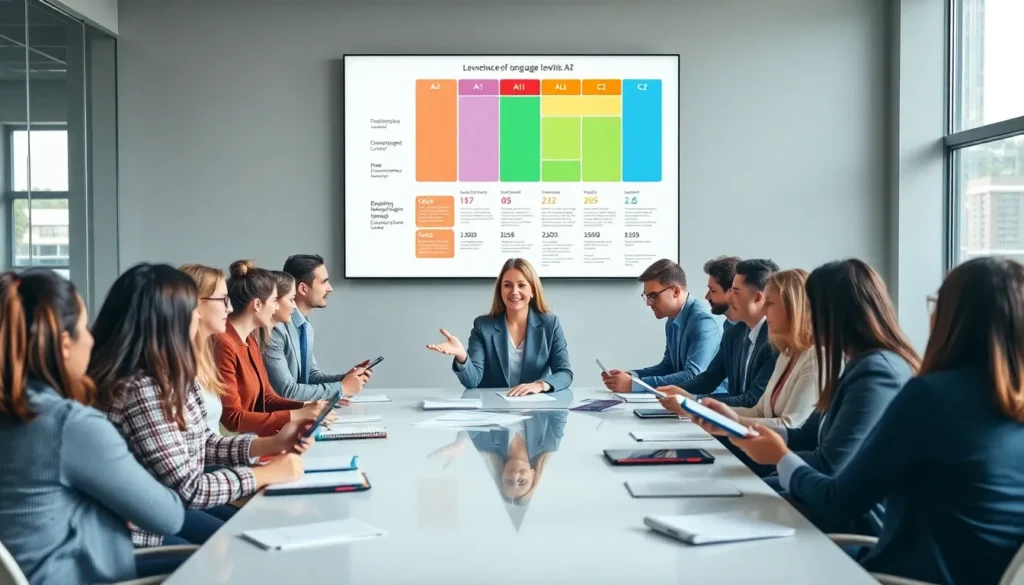Table of Contents
ToggleEver thought about how tricky language learning can be? Picture this: you’re happily munching on your morning bagel, thinking, “I really want to impress my friends by speaking fluent Spanish by next week.” Ah, the optimism. But, no worries. Understanding the “levels of language learning” helps you navigate the journey from ‘¿Dónde está el baño?’ to discussing the implications of climate change in your new lingo. In this text, we’ll dive deep into the different levels, tools, and tricks to help anyone climb the language ladder with a smile (and perhaps a few laughs along the way).
Understanding Language Proficiency

Language proficiency isn’t just about knowing a few phrases or grammatical rules. It represents a spectrum of skills that individuals accumulate as they learn. Proficiency involves the ability to understand, speak, read, and write in a new language with varying degrees of fluency and accuracy. Think of it like building a muscle: the more you practice, the stronger you become.
When navigating through language learning, proficiency levels help both learners and educators gauge where one stands in the linguistic landscape. For instance, someone might be great at ordering a coffee but struggle with writing a formal email. This is where language levels emerge to illustrate these distinctions.
The Common European Framework of Reference (CEFR)
The Common European Framework of Reference for Languages (CEFR) offers a well-structured method for defining language proficiency. Developed by the Council of Europe, it categorizes learners into six levels, ranging from A1 (beginner) to C2 (mastery).
- A1 – Beginner: Simple phrases and sentences, basic understanding.
- A2 – Elementary: Communicates in simple situations, can handle routine tasks.
- B1 – Intermediate: Engages with straightforward connections on familiar subjects.
- B2 – Upper Intermediate: Understands main ideas, can produce clear text.
- C1 – Advanced: Produces clear and well-structured text: proficient in complex ideas.
- C2 – Mastery: Near-native proficiency, can summarize and evaluate complex texts.
This framework is invaluable for educators and students, clearly laying out expectations and developmental pathways.
Stages of Language Learning
Language learning can be thought of as a journey with various milestones along the way. With each stage, learners encounter unique challenges and triumphs.
Beginner Level
At this stage, learners are often wide-eyed and eager. They learn basic vocabulary, simple verbs, and how to construct straightforward sentences. Everyday conversations about everyday things become the norm. Think of it as learning to walk, it’s about taking those first, wobbly steps toward fluency.
Intermediate Level
Once the basics are in place, learners shift gears. At the intermediate level, they begin to connect more complex ideas, explore different tenses, and expand their vocabulary. They can discuss past experiences, express opinions, and engage in slightly deeper dialogues. It’s akin to learning to ride a bike, there’s more balance, but it still takes some practice to navigate smoothly through conversations.
Advanced Level
Finally, at the advanced stage, individuals can articulate their thoughts fluently and accurately, engaging in nuanced discussions about complicated themes. They can read literature, understand idiomatic expressions, and express emotions with clarity. This is the stage where they feel like they’ve graduated from training wheels to conquering hills.
Factors Influencing Language Learning Levels
Several factors can significantly impact how quickly and effectively one progresses through the levels of language learning.
Cultural Exposure
Being culturally immersed in a language can accelerate learning like no textbook can. Watching movies, listening to music, or engaging with native speakers provides practical context. This exposure not only enriches vocabulary but also enhances understanding of cultural nuances.
Practice and Immersion
Regular practice is the lifeblood of language learning. Those who practice daily, whether through speaking, writing, or even thinking in the language, will see faster improvement. Immersion methods, such as living in a place where the language is spoken, can push learners into real-world situations that promote learning exponentially.
Learning Tools and Resources
A plethora of resources are available today, from apps to online courses, and they cater to various learning styles. Utilizing language exchange platforms, engaging with interactive applications, or even hiring tutors can provide tailored support encouraging learners to flourish.
Assessment and Evaluation of Proficiency Levels
Evaluating language proficiency plays a crucial role in understanding where one stands in the learning journey.
Standardized Tests
Standardized tests like the TOEFL, IELTS, or Cambridge exams provide structured benchmarks for assessing language skills. They help learners identify their strengths and areas needing improvement. These assessments often align with CEFR levels, making them a reliable measure.
Self-Assessment Techniques
Apart from standardized tests, self-assessment methods can empower learners to evaluate their own proficiency. Techniques like journaling in the target language, speaking with native speakers, or even recording oneself can provide significant insights into personal progress.







